电子科技大学:《语言学通论 General Linguistics》课程教学资源(课件讲稿)语义学——Context, changes in word meaning, figures of speech
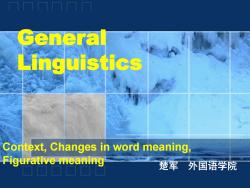
General Linguistics Context,Changes in word meaning, Figurative meaning 楚军外国语学院
Context, Changes in word meaning, Figurative meaning 楚军 外国语学院 General Linguistics
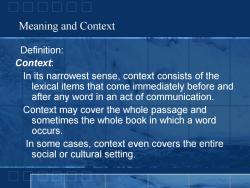
Meaning and Context Definition: Context: In its narrowest sense,context consists of the lexical items that come immediately before and after any word in an act of communication. Context may cover the whole passage and sometimes the whole book in which a word occurs. In some cases,context even covers the entire social or cultural setting
Meaning and Context Definition: Context: In its narrowest sense, context consists of the lexical items that come immediately before and after any word in an act of communication. Context may cover the whole passage and sometimes the whole book in which a word occurs. In some cases, context even covers the entire social or cultural setting
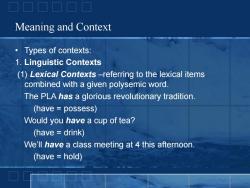
Meaning and Context ·Types of contexts: 1.Linguistic Contexts (1)Lexical Contexts-referring to the lexical items combined with a given polysemic word. The PLA has a glorious revolutionary tradition. (have possess) Would you have a cup of tea? (have drink) We'll have a class meeting at 4 this afternoon. (have hold)
Meaning and Context • Types of contexts: 1. Linguistic Contexts (1) Lexical Contexts –referring to the lexical items combined with a given polysemic word. The PLA has a glorious revolutionary tradition. (have = possess) Would you have a cup of tea? (have = drink) We’ll have a class meeting at 4 this afternoon. (have = hold)
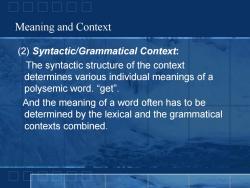
Meaning and Context (2)Syntactic/Grammatical Context: The syntactic structure of the context determines various individual meanings of a polysemic word..“get”. And the meaning of a word often has to be determined by the lexical and the grammatical contexts combined
(2) Syntactic/Grammatical Context: The syntactic structure of the context determines various individual meanings of a polysemic word. “get”. And the meaning of a word often has to be determined by the lexical and the grammatical contexts combined. Meaning and Context
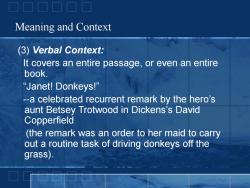
Meaning and Context (③)Verbal Context: It covers an entire passage,or even an entire book. “Janet!Donkeys!" --a celebrated recurrent remark by the hero's aunt Betsey Trotwood in Dickens's David Copperfield (the remark was an order to her maid to carry out a routine task of driving donkeys off the grass)
(3) Verbal Context: It covers an entire passage, or even an entire book. “Janet! Donkeys!” --a celebrated recurrent remark by the hero’s aunt Betsey Trotwood in Dickens’s David Copperfield (the remark was an order to her maid to carry out a routine task of driving donkeys off the grass). Meaning and Context
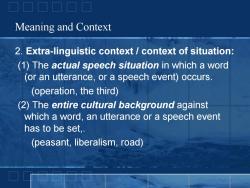
Meaning and Context 2.Extra-linguistic context context of situation: (1)The actual speech situation in which a word (or an utterance,or a speech event)occurs. (operation,the third) (2)The entire cultural background against which a word,an utterance or a speech event has to be set,. (peasant,liberalism,road)
2. Extra-linguistic context / context of situation: (1) The actual speech situation in which a word (or an utterance, or a speech event) occurs. (operation, the third) (2) The entire cultural background against which a word, an utterance or a speech event has to be set,. (peasant, liberalism, road) Meaning and Context
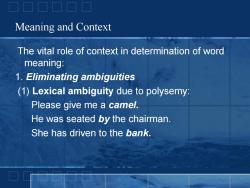
Meaning and Context The vital role of context in determination of word meaning: 1.Eliminating ambiguities (1)Lexical ambiguity due to polysemy: Please give me a camel. He was seated by the chairman. She has driven to the bank
The vital role of context in determination of word meaning: 1. Eliminating ambiguities (1) Lexical ambiguity due to polysemy: Please give me a camel. He was seated by the chairman. She has driven to the bank. Meaning and Context
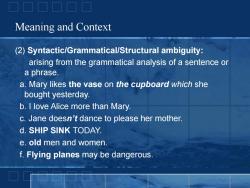
Meaning and Context (2)Syntactic/Grammatical/Structural ambiguity: arising from the grammatical analysis of a sentence or a phrase. a.Mary likes the vase on the cupboard which she bought yesterday. b.I love Alice more than Mary. c.Jane doesn't dance to please her mother. d.SHIP SINK TODAY. e.old men and women. f.Flying planes may be dangerous
Meaning and Context (2) Syntactic/Grammatical/Structural ambiguity: arising from the grammatical analysis of a sentence or a phrase. a. Mary likes the vase on the cupboard which she bought yesterday. b. I love Alice more than Mary. c. Jane doesn’t dance to please her mother. d. SHIP SINK TODAY. e. old men and women. f. Flying planes may be dangerous

Meaning and Context (3)Phonological ambiguity a.Long time no /si:/. b.My son had a /'grei'dei/today. c.I've never seen a human being killed. We can use the ambiguous phenomena in language (pun to achieve the desired result in commercial ads or to create some humorous artistic atmosphere: a.More sun and air for your son and heir. b.On Sunday they pray for you and on Monday they prey on you
(3) Phonological ambiguity a. Long time no /si:/. b. My son had a /’grei’dei/ today. c. I’ve never seen a human being killed. We can use the ambiguous phenomena in language (pun ) to achieve the desired result in commercial ads or to create some humorous artistic atmosphere: a. More sun and air for your son and heir. b. On Sunday they pray for you and on Monday they prey on you. Meaning and Context
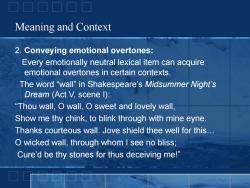
Meaning and Context 2.Conveying emotional overtones: Every emotionally neutral lexical item can acquire emotional overtones in certain contexts. The word "wall"in Shakespeare's Midsummer Night's Dream (Act V,scene l): 'Thou wall,O wall,O sweet and lovely wall, Show me thy chink,to blink through with mine eyne. Thanks courteous wall.Jove shield thee well for this... O wicked wall,through whom I see no bliss; Cure'd be thy stones for thus deceiving me!
Meaning and Context 2. Conveying emotional overtones: Every emotionally neutral lexical item can acquire emotional overtones in certain contexts. The word “wall” in Shakespeare’s Midsummer Night’s Dream (Act V, scene I): “Thou wall, O wall, O sweet and lovely wall, Show me thy chink, to blink through with mine eyne. Thanks courteous wall. Jove shield thee well for this… O wicked wall, through whom I see no bliss; Cure’d be thy stones for thus deceiving me!
按次数下载不扣除下载券;
注册用户24小时内重复下载只扣除一次;
顺序:VIP每日次数-->可用次数-->下载券;
- 电子科技大学:《语言学通论 General Linguistics》课程教学资源(课件讲稿)语义学——Semantics(Sense Relations).pdf
- 电子科技大学:《语言学通论 General Linguistics》课程教学资源(课件讲稿)语义学——Types of word-meaning.pdf
- 电子科技大学:《语言学通论 General Linguistics》课程教学资源(课件讲稿)07 Semantics(Introduction).pdf
- 电子科技大学:《语言学通论 General Linguistics》课程教学资源(课件讲稿)06 Functional Grammar.pdf
- 电子科技大学:《语言学通论 General Linguistics》课程教学资源(课件讲稿)05 句法 Syntax.pdf
- 电子科技大学:《语言学通论 General Linguistics》课程教学资源(课件讲稿)04 Formalist Approach.pdf
- 电子科技大学:《语言学通论 General Linguistics》课程教学资源(课件讲稿)03 Formalist Approach.pdf
- 电子科技大学:《语言学通论 General Linguistics》课程教学资源(课件讲稿)02 句法 Syntax.pdf
- 电子科技大学:《语言学通论 General Linguistics》课程教学资源(课件讲稿)01 Introduction(主讲:楚军).pdf
- 山东省“成人教育特色课程”项目配套教材:《大学语文》课程教材电子版(主编:戴永新).pdf
- 聊城大学:《大学语文》课程教学资源(阅读文献)中国现当代文学经典作品选.pdf
- 聊城大学:《大学语文》课程教学资源(阅读文献)外国文学经典作品选.pdf
- 聊城大学:《大学语文》课程教学资源(阅读文献)中国古代文学经典作品选.pdf
- 聊城大学:《大学语文》课程教学资源(电子教案讲义,共十五讲).docx
- 运城学院:《文学概论 literature theory》课程教学资源(电子教案,打印版,2/2,共两编八章).pdf
- 运城学院:《文学概论 literature theory》课程教学资源(电子教案,打印版,1/2,共三篇八章).pdf
- 运城学院:《文学概论 literature theory》课程教学资源(教学大纲,打印版).pdf
- 运城学院:《秘书写作 Daily practical Writing》课程PPT教学课件(事务文书写作)15.总结述职报告.ppt
- 运城学院:《秘书写作 Daily practical Writing》课程PPT教学课件(事务文书写作)14.讣告悼词.ppt
- 运城学院:《秘书写作 Daily practical Writing》课程PPT教学课件(事务文书写作)13.欢迎欢送答谢表扬邀请信.ppt
- 电子科技大学:《语言学通论 General Linguistics》课程教学资源(课件讲稿)语义学——Componential Analysis.pdf
- 电子科技大学:《语言学通论 General Linguistics》课程教学资源(课件讲稿)语义学——Sentence meaning(Predication Analysis).pdf
- 电子科技大学:《语言学通论 General Linguistics》课程教学资源(课件讲稿)10 Langugae, culture & society.pdf
- 电子科技大学:《语言学通论 General Linguistics》课程教学资源(课件讲稿)09 Pragmatics(Utterance Meaning).pdf
- 电子科技大学:《语言学通论 General Linguistics》课程教学资源(课件讲稿)形态学 Morphology.pdf
- 电子科技大学:《语言学通论 General Linguistics》课程教学资源(课件讲稿)认知语言学中的相关话题 Cognitive Linguistics.pdf
- 弟子规(全文).pdf
- 《中国语言文化 Chinese Language and Culture》课程教学资源(书籍阅读材料)《中国古典哲学名著选读》郭齐勇.pdf
- 《中国语言文化 Chinese Language and Culture》课程教学资源(书籍阅读材料)《唐诗三百首》中英文对照(许渊冲)300 Tang Poems(Classified by Theme).pdf
- 《中国语言文化 Chinese Language and Culture》课程教学资源(书籍阅读材料)《二十四诗品校注译评》祖保泉.pdf
- 《中国语言文化 Chinese Language and Culture》课程教学资源(书籍阅读材料)《近代中国之种族观念》刘东.pdf
- 《中国语言文化 Chinese Language and Culture》课程教学资源(书籍阅读材料)《中国现代女作家与中国革命1905-1948》颜海平.pdf
- 《中国语言文化 Chinese Language and Culture》课程教学资源(书籍阅读材料)《世界秩序与文明等级》全球史研究的新路径(主编:刘禾).pdf
- 《中国语言文化 Chinese Language and Culture》课程教学资源(书籍阅读材料)《叫魂》SOULSTEALERS - The Chinese Sorcery Scare of 1768〔美〕孔飞力(1768年中国妖术大恐慌).pdf
- 电子科技大学:《中国语言文化 Chinese Language and Culture》课程教学资源(课件讲稿)导论(聂韬).pdf
- 电子科技大学:《中国语言文化 Chinese Language and Culture》课程教学资源(课件讲稿)第一讲 周易.pdf
- 电子科技大学:《中国语言文化 Chinese Language and Culture》课程教学资源(课件讲稿)第七讲 谶纬之学.pdf
- 电子科技大学:《中国语言文化 Chinese Language and Culture》课程教学资源(课件讲稿)第三讲 山海经.pdf
- 电子科技大学:《中国语言文化 Chinese Language and Culture》课程教学资源(课件讲稿)第二讲 尚书.pdf
- 电子科技大学:《中国语言文化 Chinese Language and Culture》课程教学资源(课件讲稿)第五讲 道家与魏晋风度.pdf
